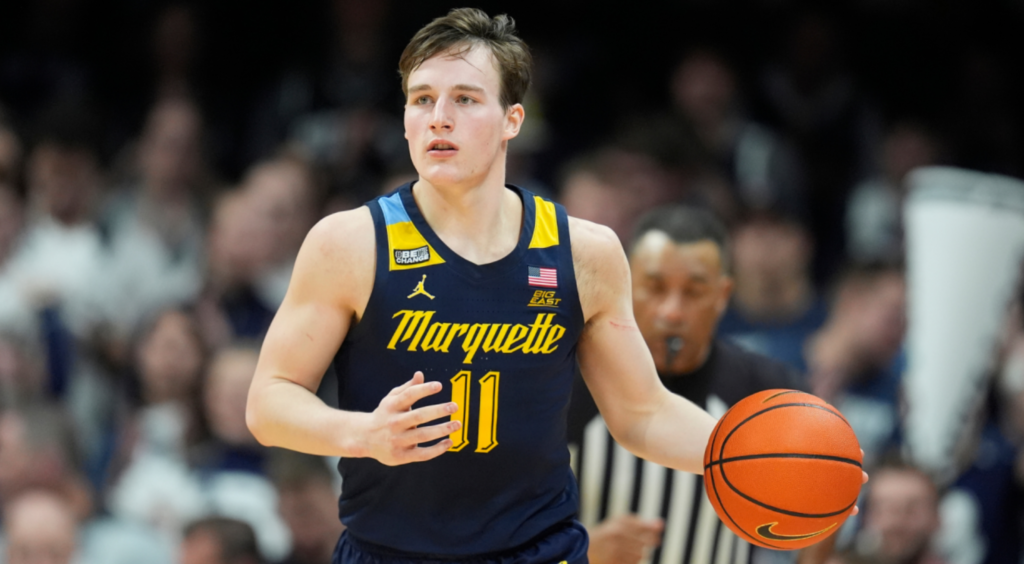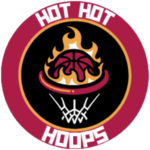
We are through one round in the 2024 NBA Draft, with the Miami Heat selecting Indiana big Kel’el Ware. Heading into Thursday’s second round, Miami owns the No. 43 pick. Who are some available names for them to consider? Let’s dive into it!
Tyler Kolek, G, Marquette
Even though he’s not a player I think will be available at No. 43 (that’s why I excluded Furphy), Kolek was a prospect I identified for the Heat to monitor at No. 15 in mid-May. Here’s what I wrote previously about him:
“Kolek, a consensus All-American in 2023-24, is arguably the best pure point guard in this class.
He led the Big East in assist percentage in each of the last three seasons and finished in the top-5 nationally in that category the last two seasons. The southpaw is an exceptional passer with adept processing speed—improving his live-dribble reads from season-to-season. Kolek is also a very good spot-up shooter, knocking down 39.3 percent of his long-range attempts over the last two years.
I am admittedly not great with NBA comparisons—nor do I make them often—but Kolek reminds me of former Heat guard Goran Dragic. He may be small, but Kolek plays with an ultra-feisty competitiveness and played in plenty of big games at Marquette.”
If I were to make a bet, I think Miami will take a guard in the second round. But that’s my hunch.
Kevin McCullar Jr., G/F, Kansas
McCullar’s floor spacing was pretty inconsistent, but he’s one of the smartest players left in my view. He’s excellent off-ball–especially as a cutter–and developed as a secondary playmaker in Kansas’ offense.
McCullar’s got great instincts with a strong motor off-ball defensively, making the right rotations with a knack for playing the passing lanes or corralling steals. He’s smart and cerebral with a dose of toughness I like.
Offensively, he wasn’t a prolific shooter, but his 75.6 percent career free-throw percentage (80.5 FT% as a senior) suggests there’s some improvement. He’s got a high release, arc and an elevated lift. He was much better as a slasher, attempting over 40 percent of his shots at the rim as a senior at a 63.5 percent clip.
Jonathan Mogbo, F, San Francisco
“Mogbo, 22, who played at four schools in four collegiate seasons, is one of the better players that many may not know about.
He may be the best playmaking big in this class, averaging 3.6 assists with a 24.5 assist percentage (!!) in his lone season at San Francisco. The Dons ran offense through him, and he was elite at pinpointing shooters/cutters and initiating offensive above-the-break or at the nail. He’s another undersized big who needs to space the floor, but he’s another high-motor 6-foot-8 athlete who makes smart decisions and rebounds at a very high level.
He plays four inches bigger than he is when he gets to the lane and I trust his decision-making with the rock in his hands. I wouldn’t be surprised if the Heat took a second-round flier on him. Mogbo’s pretty fluid with his movements and could leverage his unique skillset to potentially crack an NBA rotation at some point down the line.”
Jamal Shead, G, Houston
“You could make the case that Shead is the best guard defender on this class. He’s yet another small guard who wouldn’t quite solve Miami’s “lack of size” conundrum, but I would consider Shead with the No. 43 pick if the Heat went with a (big) wing or backup big at No. 15.
Shead brings a tenaciousness that’s unrivaled in this class. He was the Big 12 Player of the Year and Defensive Player of the Year, averaging 12.9 points, 3.7 rebounds, 6.3 assists and 2.2 steals on 49.5 percent true shooting. The Heat have a history of going after smaller guards who are very good at the point-of-attack–Sup, Briante Weber and Marcus Garrett–but Shead has far more ball-skills with both of them.
He developed into a legitimately good point guard with good decision-making and leadership. Shead was the heartbeat of Houston’s 32-5 season. He’s got a bulldog mentality on the court who’s not afraid to stick his teeth into bricks. Miami likes that.”
Pelle Larsson, G, Arizona
“We don’t know what the Heat’s offseason plan entails. Nobody knows. But should they move on from at least one of Tyler Herro or Duncan Robinson, Larsson could be a player to help supplement production. His counting stats–12.8 points, 4.1 rebounds and 3.7 assists–don’t jump off the whiteboard. But Larsson was one of Arizona’s top glue guys and one of the Pac-12’s most efficient 3-point shooters.
Larsson was the only player in the country to total 1,200 points, 500 rebounds, 300 assists and 100 steals while shooting at least 49 percent from the floor and 39 percent from the 3-point range from 2020-24. He was a smart, comfortable decision-maker as a secondary creator; he was also very comfortable running off screens, relocating and spotting up off-ball. Larsson wasn’t the perfect defender, but he wouldn’t be afraid to take on tough-er assignments and play both ends.
If you’re looking for a complementary, big guard who can be a secondary/tertiary creator, Larsson is as good of an option as there will be in the second round.”
Keshad Johnson, F, Arizona
Johnson is one of the most athletic players left in the class; he featured a 31.5-inch standing vert, but had a combine-best 42-inch max vert when he tested. Johnson wasn’t a player that always popped off the box score at Arizona alongside Larsson, Caleb Love, Oumar Ballo and Kylan Boswell, but Johnson’s one of the best defenders left in the class. He’s versatile–he’s strong enough to guard up, but quick enough to hold his own against smaller guards.
He has a very strong base and center of gravity defensively. Johnson, who has a plus-four wingspan (6’10.25″) with a sturdy 225-pound build, had incredible instincts and can cover plenty of ground in a short amount of time–a premium in today’s spaced-out NBA. To top it off, he’s got an A-motor who positions his body well on- and off-ball with good hands.
Johnson was an abominable shooter in his four seasons at SDSU but improved to 38.7 percent from deep on fairly low volume last year. I would take a flier on him due to his physical tools alone, even though there will be development to be had offensively.
KJ Simpson, G, Colorado
“I don’t expect Simpson to be available in this range. If there was one player on this list that I think is the likeliest to be gone, I think it’s Simpson. But he’s one of my favorite guards in this class. He’s not the biggest guard ever, but he was an exceptional 3-point shooter with a lightning-quick release and good lift.
Like Ingram, he’s going to have to prove his one great shooting season wasn’t a fluke. He shot 43.4 percent on 4.9 attempts (35.5 3PAr) as a junior; he shot a combined 26.9 percent on 3.3 attempts (33.3 3PAr) in his first two seasons. That’s a stark difference. But Simpson, who has fluid shot mechanics with a high release point, shot 79.8 percent from the free-throw line in his first two seasons and 87.6 percent from the free-throw line as a junior on reasonable volume. There were indications it’d improve.
He’s also a very good floor general. Simpson was comfortable operating on- and off-ball in Colorado’s offense alongside Tristan da Silva, Cody Williams–a pair of projected first-rounders–plus J’Vonne Hadley. He knows when to attack and when to not attack. He was good in the pick-and-roll and could be a decent point-of-attack defender, despite being undersized at 6-foot-1.”
Jalen Bridges, F, Baylor
Bridges was Baylor’s most efficient 3-point shooter a year ago, knocking down 41.2 percent of his 5.1 triple tries last year. His biggest knock is his raw athleticism, but Bridges would leverage his 3-point shooting in attacking closeouts, where he was very efficient around the rim.
He’s got a very quick release from distance and was an above-average rebounder, hauling down 11.3 percent of his team’s total misses. He was also one of Baylor’s most sound defenders, and he showed good instincts on- and off-ball with good lateral mobility.
Overall, Bridges was very productive in a limited role and projects to be a 3-and-D archetype at the next level.
Antonio Reeves, G, Kentucky
Reeves may have shared a backcourt with first-round picks Reed Sheppard and Rob Dillingham, but you could the make case that Reeves was (at times) the most important of the trio. The five-year college journeyman was one of the best high-volume 3-point shooters in the country, especially in transition. He isn’t a one-trick pony and can score in the halfcourt against over-aggressive defenses at multiple levels. His biggest knock is his defense; he’s skinny and churned out inconsistent results on that end. But his offensive upside as a shooter with some secondary creation capabilities is intriguing.
Harrison Ingram, F, UNC
“After spending two seasons at Stanford, Ingram had a career year at North Carolina. He averaged 12.2 points, 8.8 rebounds and 1.4 steals in 32.8 minutes per game. Ingram developed into a capable 3-point shooter, knocking down 38.5 percent of his 4.6 triple tries (44.6 3PAr). Though he’ll have to prove his two seasons at Stanford (31.6 3p%; 3.5 3PA) were an aberration.
Ingram, standing at 6-foot-7 with a 7-foot wingspan) is an exceptional rebounder for his size–sporting a 20.1 defensive rebounding percentage and a 14.5 rebounding percentage in 203-24. He’s not very explosive vertically, but is very physical when attacking the lane and showed flashes of a low-post game last year. Ingram projects to be a 3-and-D body, and in today’s NBA, you could never have enough of those.”
Cam Spencer, G, UConn
Spencer is a hand-in-glove fit for the Heat from a competitive spirit standpoint. He runs hot in the best way imaginable. He was a lights-out shooter over his five combined seasons at Loyola (MD), Rutgers and UConn–only having one season where he shot below 43.0 percent from long-range.
He played within the flow of UConn’s offense and made the proper reads. He was a smart, fiery player. Though I question how he holds up athletically against NBA-caliber athletes, however.
***************
Honorable mentions:
Juan Nunez, G, Germany: You could make the case that Nunez is the best passer in the class. He’s a wicked floor general … but he also may be the worst athlete.
Tyler Smith, F, G-League Ignite: I wrote plenty about Smith here. I don’t think the Heat go with another near 7-footer. But if they do, turning in the card for Smith is a very good option.
Nikola Djurisic, G/F, Mega Basket: A former teammate of Nikola Jovic! Djurisic is a very creative passer, even though he possessed a very mixed bag of shooting in the Adriatic League.
Bobi Klintman, F, Australia: Klintman played one season with Wake Forest before testing his skills overseas. He’s a big wing who’s raw on both ends with some two-way upside. Klintman would benefit from Miami’s developmental system, but it would take time.
***
To check out our other content, click here.
Follow Hot Hot Hoops on Twitter/X here!
Follow Hot Hot Hoops on Instagram here!
Subscribe to our YouTube channel here!

I don’t think Kolek will be there, so this is my ranking of wants of guys with a chance to be there.
Larsson-K. Johnson-McKullar-Shead-Bridges-Ingram
I would be good with either of these, but want one of those first three. Let’s go HEAT!
Some good rotation/bench players there.